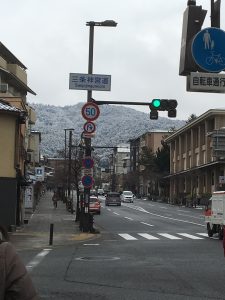
We were blessed with some minor overnight snow today! We met at around 9:45am at the hostel lobby and took the subway to Higashiyama, which was near the Kanze Noh theater. Upon leaving the subway, we were greeted with this sight! Unfortunately, my zoomed-in iPhone camera really doesn’t give the sight justice.
We had seats on the 2nd floor, which did not have seating assignments, so we hurried and managed to squeeze into the second of three rows in front of the stage. As the time for the performance approached, a flute sounded with an announcement and the actors shuffled onto the stage one by one. First up was the okina, which was very much as Bethe-sensei had described. I don’t know if anything the actors said had specific meaning, but I remember from the lecture that some of the chanting didn’t have meaning and was for ritual’s sake. It was interesting to see aspects that Bethe-sensei had described, such as the purification of areas of the stage. In a way, I was excited to see the parts I recognized, such as in the beginning, when the box with the mask was brought in and bowed to, like a shrine, and prepared for the shite actor later. The aspects of heaven and earth with the white and black masks was also more easily seen, and looking at the masks in person was very impressive, though I do wish I was a little closer up (or that my eyes were a little better) so that I could see the detail a bit better. It’s also incredible how many years of tradition and history lie in those masks, worthy of deification in itself. I also couldn’t stop thinking about the amount of preparation and purification that the shite went through before the performance.
Afterwards, we went into Yumi Yawata, where the actors shuffled on stage, hayashi first, which were the instrumentalists, with the chorus coming through a side door, the waki and 2 waki-tsure, or his attendants, and then eventually the shite (and attendant), when the time came for his appearance. I’m wondering a bit about the purpose or role of the side attendants. Could it be tradition that was kept? Do they require a speaking role that the main actor cannot do? The program helped a lot in translating the story directly, but I could see a bit how it could be helpful and distracting. While there were times where I would get absorbed in reading footnotes and translation and look up, where no one had moved or changed positions, there were also times in which I would look up and realize I was missing important movement. I also enjoyed the god dance, where I looked for some of the fan positions that Bethe-sensei told us about. It was also fun recognizing the rhythms that we had done in the lecture, and I was mesmerized for a little bit trying to guess the patterns and the way the meter sped up.
After Yumi Yawata was the kyogen, Niwatori Muko. I LOVED this. I could come back to watch kyogen any day, to be honest. The movement was so humorous, the intonation, even, of the lines, and the way everything was expressed was very amusing, and a good break, in comparison to the okina and Noh from before. Something about the flopping of the rooster hat, and the cock-a-doodle-doo-ing was just so humorous, and the fact that the father-in-law went along with his son-in-law and they unanimously cock-a-doodle-doo-ed together was somehow heartwarming and, of course, quite funny. I do remember that, technically, a kyogen actor’s purpose should not be to make the audience laugh, per se, but I think in any art, there is the aspect of thinking about the audience.
We had a short break afterwards, where we chowed down on bento, which was delicious:
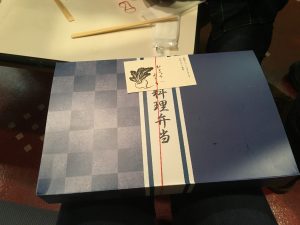
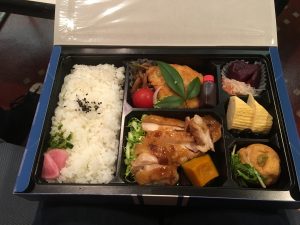
There was also free tea available to drink, which was warm and pleasant. In the bento was rice, fried fish with katsu sauce, a cherry tomato, and some kind of noodle, chicken with a chunk of pumpkin, a fried (or boiled?) tofu with some kind of spice in it, egg with some sweetened black beans, and pickled radishes and a dessert-like fruit that looked marinated and tasted of peach or plum. Absolutely delicious!
We shuffled back into our seats to watch Toboku, where I really got a sense of the elegance and lyricism of the play. I found it a bit slow, but in a sense, the slowness allowed the grace to come through, as I felt that the movements were more subtle and nuanced than Yumi Yawata. The dance in particular, though it had some moments of flair, was very gentle, in a sense. I think around this time, I really got a sense of the Noh performance itself as an ensemble. While, of course, there is the ensemble of the chorus and the musicians, Noh really works together in itself like an ensemble would. The actors, musicians, chorus, and stagehands are all connected together, responding and listening to one another, and moving appropriately, similarly to a well trained and tuned orchestra. In a piece like this, this kind of ensemble is even more noticeable, as it allows you to notice subtle movements and careful watching that link things such as the music and rhythm to the footsteps of the shite.
In between the Noh plays and kyogen, there were also dances without music, accompanied by just 4 chorus members. I asked Bethe-sensei what these were, as I hadn’t read about them before and it wasn’t listed in the program. These dances are extracted from Noh plays, and also allow members who otherwise would not headline in the major play to perform in itself. I particularly enjoyed the last dance before the performance of Iwafune, which Bethe-sensei told me was also dragon dance, and could see the resemblance of power and movement to the dance of the dragon in Iwafune.
Iwafune was probably my favorite play. It was quite short, but I was very excited to see the dance. All throughout, we saw many amazing Noh costumes, and I really enjoyed the dragon’s use of gold (all the costumes of shite previously also had gold), as well as the contrast with the red wig, and especially, the gold dragon at the top of the head, which veered itself in our direction whenever the actor snapped his head forward. For some reason I can’t quite explain, I was surprised when the actor turned to a stagehand and swapped his oar with the fan for the dance. As his body covered the exchange, when he turned around the reveal the fan, I was amazed, in a sense. The play was over before I knew it, and I almost wished that it was longer so I could experience more of this powerful dance. Additionally, I noted the jo-ha-kyu present in the performance program–how Yumi Yawata started out slow and beginning, with Toboku getting deeper into the program and more involved, and finally becoming fast and exciting with Iwafune. The kyogen also seemed to act as a tool to get us deeper and more involved into the program, even though it could be considered a “break” from the material.
All in all, Noh was a great experience to watch. I’m really looking forward to going to the workshop for more hands-on experiences that will enhance my understanding!
We split off afterwards, Si Hou, Breelyn, Franky, and I heading to the Kyoto Modern Museum of Art. Unfortunately, it had closed and we were unable to enter. We waited for Breelyn to go into Heian-ji, which was right next to it, and learned about about the history from Sachi-san. You can see how big this gate was!
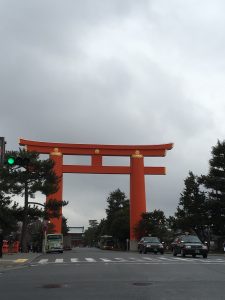
Heian-ji was apparently established after the founder of the Heian capital, about 1000 years after. It seems that he was deified after death because of his deeds, and this temple is here to honor him.
We tried to find the Jump store, near the Kyoto JR station, which unfortunately, doesn’t seem to exist. Regardless, we spend quite some time in the Yodobashi Camera building, which was supposed to have the Shounen Jump store. We did at least get to see Kyoto Tower, try on some clothes, do gachapon machines, and have a DELICIOUS dinner, which was at Shirokujichu, a place with wooden rice bowls, at the top of the Yodobashi Camera building, which housed a large and extensive amount of restaurants. I had what was essentially a sea sampler on top of my rice, with raw fish, roe, and shrimp. There are three ways to eat it: by itself, with the special sauce that comes with the dish, and as ochazuke. It was absolutely delicious any way!
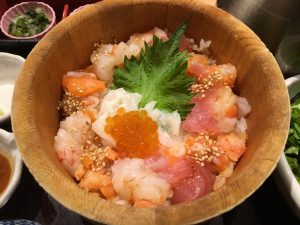
Yet again back at the hostel, ready to shower and go to bed in preparation for an exciting day tomorrow!

